Surgery repairs dramatic 150-degree curvature
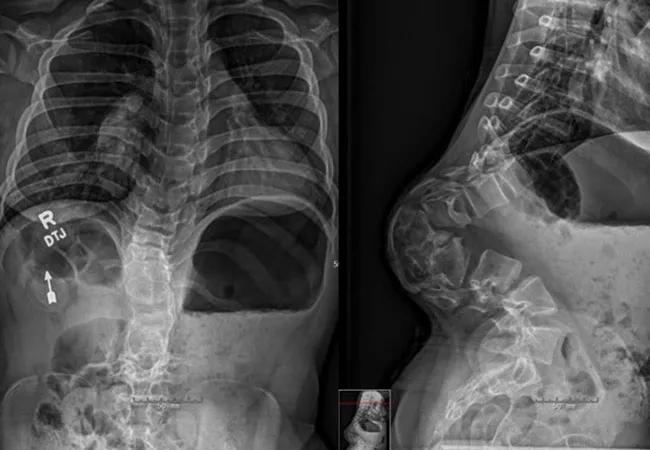
Cleveland Clinic is a non-profit academic medical center. Advertising on our site helps support our mission. We do not endorse non-Cleveland Clinic products or services. Policy
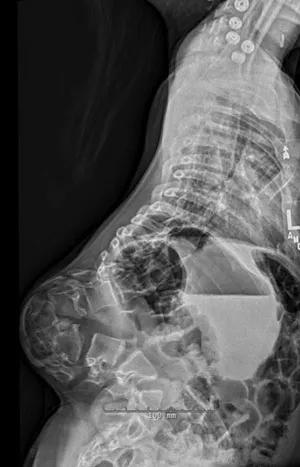
Lateral radiograph of the full spine showing significant kyphosis of the thoracolumbar region
A 15-year-old girl with achondroplasia and kyphoscoliosis presented to Cleveland Clinic Children’s Center for Pediatric Orthopaedics and Spine Deformity in the fall of 2014 with neurological symptoms, including worsening radiculopathy and myelopathy. The patient had undergone a spinal fusion at 18 months of age at another institution. Over time, her kyphoscoliosis progressed significantly, and although she was still ambulatory, her pain had become intolerable.
Achondroplasia is the most common form of skeletal dysplasia and is caused by a mutation in the gene that codes for fibroblast growth factor receptor 3 (FGFR3). It is associated with normal intelligence and in most cases normal longevity; however, it results in short-limbed dwarfism and a complex array of medical issues best managed through a multidisciplinary approach. In patients with achondroplasia, thoracolumbar kyphosis is thought to arise from the combined impact of macrocephaly, hypotonia and joint hypermobility.
Thoracolumbar kyphosis can appear in as much as 94 percent in patients with achondroplasia less than 1 year of age, gradually declining to 11 percent by age 10, and then increasing to 35 percent by 30-50 years of age.Most deformities do not progress as significantly as we saw in our patient.
In our patient, full-length antero-posterior and lateral radiographs of the spine revealed an astonishing 150-degree kyphosis. Kyphosis greater than 50-degrees can warrant surgery, even in the absence of neurological symptoms, due to the risk of progression. We found it remarkable that this patient’s neurological function remained intact despite her extreme deformity.
Radiographs and outside MRI also confirmed significant deformity of the thoracolumbar spine as well as tethering of the cord over the apex of the deformity. Considering the patient’s extreme deformity and the likelihood of progression, our only option was a very aggressive surgical approach.
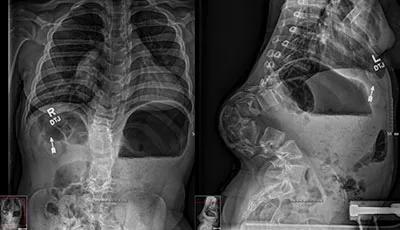
Figure 1. PA scoliosis radiograph of full spine showing mild scoliotic deformity Figure 2. Focused radiograph the the kyphotic deformity. This portion of the spine is typically straight or lordotic.
We chose a short-segment fusion with pedicle subtraction osteotomy at the apex of the deformity. Despite the procedure posing significant risk for serious neurological complications, we felt this would offer our patient the best chance to realign the spine, minimize tension on the nerves and above all prevent future neurological decline. Our hope was to reduce her curvature from 150 degrees to a much better biomechanical position.
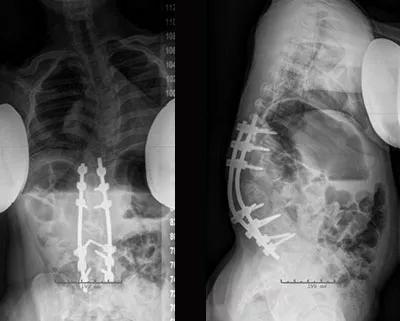
Figures 4 and 5. Postoperative PA and lateral radiographs of the spine after double pedicle subtraction osteotomy (PSO) at levels T12 and L1 with correction of alignment
We performed this six-hour procedure from an all posterior approach. Thin scar tissue from previous surgery overlaid the posterior elements of the spine. As the area was decompressed, the posterior bone was also very thin and spinal cord and nerve roots were very compressed and tethered within this area. We achieved excellent fixation with pedicle screws three levels above and below the planned area for osteotomy. Once the spine was stabilized, we further decompressed the spine for neural protection and began our spine osteotomy.
After a two-level osteotomy and further decompression above and below this area, the spine was gradually reduced to a much improved position. We performed neurological monitoring throughout the entirety of the procedure, and no changes occurred. Due to the very thin scar tissue that covered the spine, we worked with one of our plastic surgery colleagues to assist with paraspinal muscle flap closure. The fusion was from T9-L4 and the osteotomies were performed at T12 and L1. We used a custom Thoracic-Lumbar-Sacral Orthosis (TSLO) brace for 4 months postoperatively for protection and comfort.
The patient recovered well and began limited physical therapy in the hospital. She was discharged on postsurgical day six.
Her activities were restricted for the first six months postsurgery. She was not allowed to bend at the waist, lift greater than 10 pounds or twist through the torso. After six months, she began yoga, core strengthening and reconditioning.
Now age 18, the patient has maintained good lower extremity strength and bowel and bladder function. She feels she is walking better than she could prior to surgery. The pain in her back and her radiculopathy is almost fully resolved. She reports being very happy that she can lie on her back, which she was unable to do prior to surgery. We do not expect her to need further surgery.
Surgery for such severe scoliosis and kyphosis in patients with achondroplasia carries grave risks for catastrophic complications and is challenging, especially in older patients who have undergone previous spinal fusion. Institutions with pediatric spinal deformity teams and a dedicated anesthesiology group are likely to offer patients the best outcomes.
This case underscores the importance of monitoring deformities early and often. We think this patient came perilously close to potentially irreversible paraplegia.
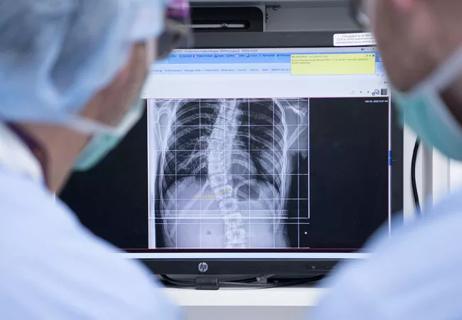
Cleveland Clinic pediatric spine surgeon shares his insights
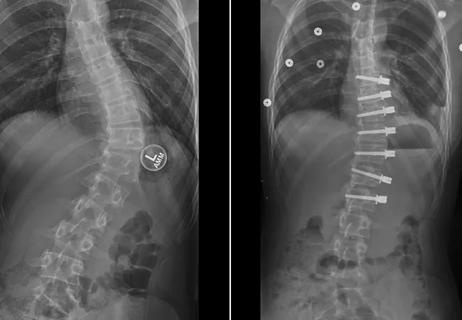
Non-fusion technique shows early promise
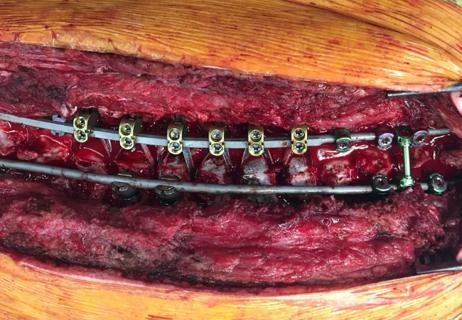
Magnet-driven growth rods are effective, less invasive for select patients
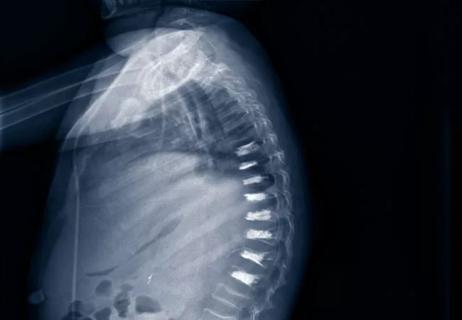
Percutaneous vertebral augmentation proves safe and effective

Improved accuracy and fixation strength in spine surgery
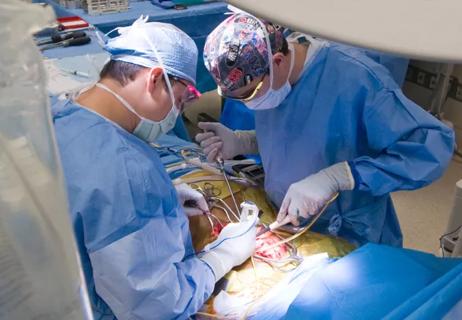
Multicenter study demonstrates rate of complications
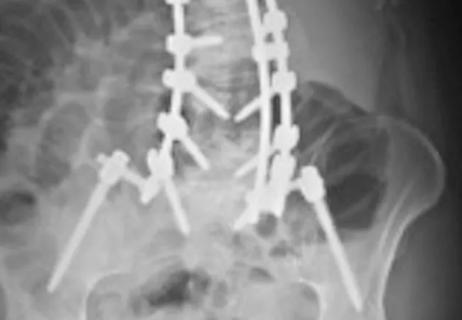
Surgical correction appropriate for subset of patients
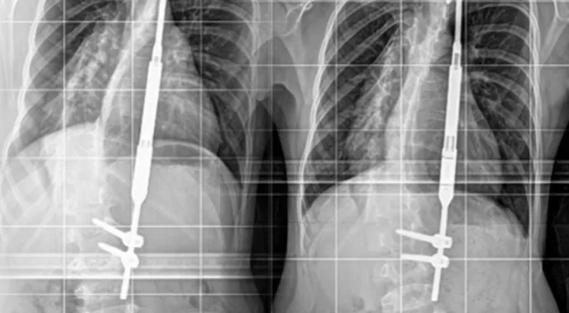
Reflections following one of the device’s first placements in the U.S.